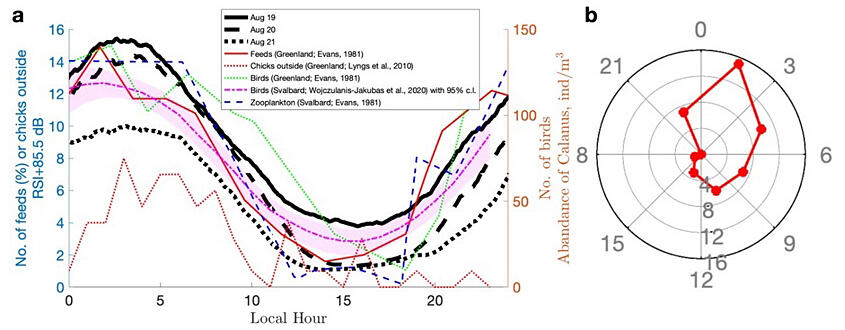A research group led by Associate Professor Evgeny A. Podolskiy of the Arctic Research Center at Hokkaido University and Drs. Anders Mosbech and Kasper L. Johansen of Aarhus University (Denmark) announced that their analysis of recordings of vocalizations and wing flapping sounds in a colony of the Arctic-breeding seabird, the little auk (Alle alle) to investigate their circadian rhythms have revealed that the birds had a diel rhythm even under the midnight sun. They continuously recorded all sounds in the colony and extracted vocalizations and wing flapping sounds from the data. This finding is important for understanding the behavior of birds in environments under continuous daylight conditions. The results were published on March 15 in the international academic journal Communication Biology.

b) Peak occurrence hour of birds sitting on the rocks in the plot area as recorded by camera in Qoororsuaq, Northwestern Greenland.
Podolskiy, E.A., Ogawa, M., Thiebot, JB. et al. Acoustic monitoring reveals a diel rhythm of an arctic seabird colony. https://doi.org/10.1038/s42003-024-05954-8. CC by 4.0
Siorapaluk in Greenland, the world's northernmost place inhabited by natives, is known as the largest breeding area for the little auk. About 6 million little auks migrate to this area in the summer. This is the 'Midnight Sun' season, when the sun never sets in the area. It was unknown what kind of circadian rhythm little auks have in such an environment. The bird is also an important game species for the Inuit living in the region and used for production of the traditional fermented food kiviaq.
In this study, the research group continuously recorded all the colony sounds in the breeding area of the little auk and extracted data to analyze sound intensity and patterns. The results confirmed a cycle in which all sounds made by the little auk were weakest during the day, particularly from 2:00 PM to 4:00 PM, and were strongest late in the night between 2:30 AM and 3:30 AM. This was consistent with the population size and chick feeding patterns in the colony, as well as the biomass cycle of plankton, their primary prey species. Similar to the trend in the recorded data, the number of little auks in the colony peaked late in the night, and chick feeding was also most active at this time of the day.
The acoustic activity cycle was confirmed to correlate well with their daily behavioral pattern, in which they gather and engage in activities, such as feeding, in the colony from midnight to dawn. This study demonstrated the effectiveness of acoustic monitoring with microphones for shedding light on the behavioral patterns of wild animals.
Podolskiy said, "In my daily life, I am always amazed at the precision of the birds' sense of time, as they start singing in chorus at sunrise. I have been studying the Arctic environment for many years, and one day I asked myself, 'When do birds sing in the midnight sun season, during which the sun never sets?' I started this study because I became interested in answering this question. This simple curiosity led to some very interesting discoveries that will help us understand the behavior of seabirds in the Arctic region and establish a method to observe them automatically and remotely. We will continue our acoustic monitoring to investigate the birds' behavior under climate change."
Journal Information
Publication: Communication Biology
Title: Acoustic monitoring reveals a diel rhythm of an arctic seabird colony (little auk, Alle alle)
DOI: 10.1038/s42003-024-05954-8
This article has been translated by JST with permission from The Science News Ltd. (https://sci-news.co.jp/). Unauthorized reproduction of the article and photographs is prohibited.




